Taking off the blinders when choosing a tree

There are so many choices when selecting a tree. Left to right, Chinese pistache, white fringetree, fruitless Sweetgum.
Prior to teaching for 33 years, my wife and I both worked at what was then the premier garden center in Knoxville. As summer would finally come to an end we had shirts, buttons, and posters that would proclaim “Fall is for Planting!” This is SO true of trees. The ideal window being from mid-October through Christmas. So, on with the show:
We are creatures of habit. I count myself part of that group of people who has a favorite menu item and really struggles to venture beyond what my tastebuds crave. Our narrow focus also applies to how we choose a tree. An unusual analogy but I’ve stretched further.
For those of us in the Southeast, the flowering dogwood (Cornus florida) is the one tree that 93.7% of us can identify (I just made that up). It’s sometimes tough to find a yard that doesn’t have one. I have nothing against these guys as they are beautiful trees with multiple seasons of interest. In my town, we have the annual Dogwood Festival, scenic Dogwood trails on which to cruise, and “Dogwood” is even part of our address. My beef is that there are so many other choices from which to pick.
Before I go further, I will admit that I’m trying to cover a lot of ground in this writing and confess there will be some generalizations. For one thing, there is size. Dogwoods are what I would call smaller, ornamental trees. Put them in the same category as flowering cherry and redbud. All of these have beautiful flowers but none are what I would call a true legacy shade tree. I love to use the word “legacy” as I interpret this to mean large shade trees whose life expectancy far outlasts that of a human. You plant these for you, your children, and your grandchildren. With that being said, I can also confess that I am at the age where I kind of quit being too concerned with how large a tree will ultimately grow. Mortality, right?
We had some wicked storms this summer in our area and sadly, several large trees crashed to the ground. We have a friend whose home was totaled when a massive beech tree hit the roof and caused all walls of the home to separate at the corners. Fortunately, this person is planning to salvage all that can be and reconstruct the home in the same style.
As a result of that storm, several folks in the area have gone to the extreme and promptly cut down ALL their trees, whether they were a future threat or not. I know it’s a personal decision but I hope these fears will subside eventually and trees that grow to the sky will still be planted.
This writing could spin off in so many directions but for a change, I’ll attempt to hold on to the reigns and try to stay close to the title. So, without any further rambling, here are some of my top recommendations in order that we all diversify our horticultural portfolios a smidge:
LARGER DECIDUOUS TREES – (Of course, I’m sure you all know that deciduous means these plants lose their leaves)
White Oak – Quercus alba

According to Dr. Doug Tallamy, author of Bringing Nature Home, the white oak is the most valuable tree in the mid-east with respect to support of wildlife diversity. These giants are the nearest thing we have to the American Chestnut that used to dominate our forest until their demise due to the chestnut blight. Of course, many won’t plant these majestic giants because “they’re messy”. Personally, I love the sound of acorns raining down on the roof each fall.
American Beech – Fagus grandifolia

The American beech, like the white oak, has a tap root which may be the reason many nurseries do not stock it but they can be found. Most have a great fall color and hold their straw-colored leaves throughout much of the winter. I love the way the young ones (sons of beeches) create a rustling sound as the wind blows through them on a sunny winter day.
Bald Cypress – Taxodium distichum
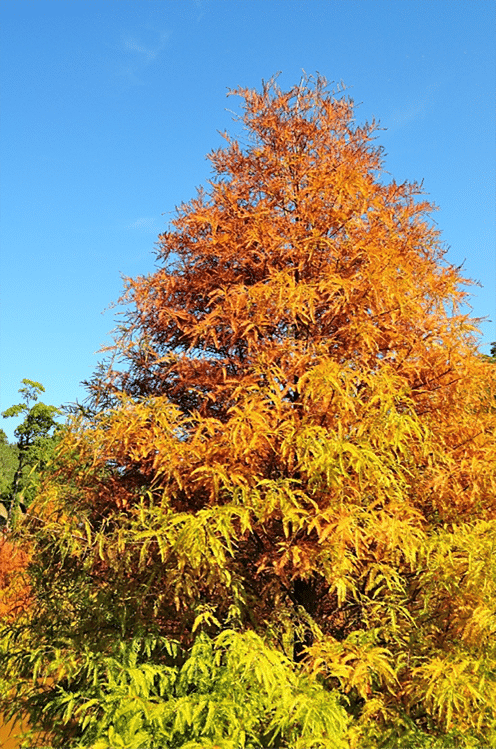
This is a great tree for slightly narrower spaces as it is more upright than sprawling. The bald cypress is different in that it is a deciduous conifer (cone-bearing plant). These take on a nice rusty color in the fall.
SMALLER DECIDUOUS TREES –
White Fringetree – Chionanthus virginicus
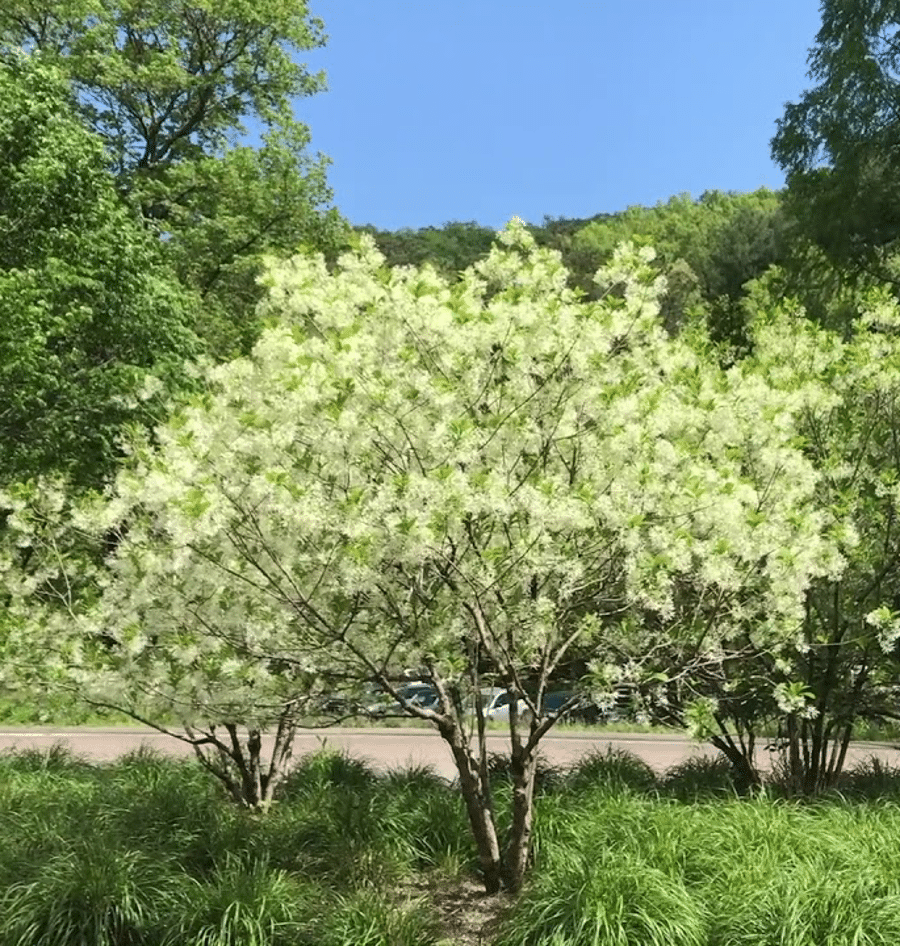
This small tree is SO underused. They have amazingly delicate-looking white blooms with a nice but not overpowering fragrance. These do well in some light shade but I’ve also seen them succeed in a hot, blazing parking lot, believe it or not.
Paw Paw – Asimina triloba

Few people have tasted the fruit of paw paw but personally, I find them delicious, IF you catch them at their prime. We have a couple and the first year I tied little mesh bags over the fruit to protect them from raccoons and other opportunists. This year there will be no need as it looks like there will be plenty for everyone. (These guys DO colonize a bit so if you don’t want a grove you may have to remove some young volunteers – or give some away!)
Serviceberry – Amalanchier

This is a nice, multi-season tree (it has flowers, fall color, and berries). Most are multi-stemmed but you can find single trunked plants if you look hard enough. The fruit is edible and it’s a great small tree for wildlife.
LARGER EVERGREENS –
Norway Spruce – Picea abies

Think Christmas tree for this one. They have a beautiful, conical form that can reach the sky. Some say they struggle in the south but I still see many in our zone 7 region. Many birds make their homes in these and deer pretty much leave it alone.
Eastern Red Cedar – Juniperus viginiana
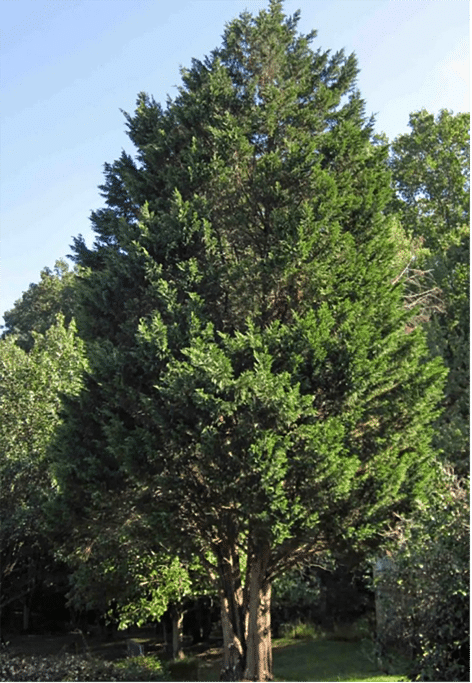
This tree gets a bad rap in my region mainly because it’s so plentiful. Ask any old farmer and they’ll tell you they love cedars…for fenceposts! Cedar is a habitat maker as it plays host to many of our songbirds. There is a cultivar out there called “Brodie”. Not sure where the improvement lies but some are more accepting if it has a fancier name.
Southern Magnolia – Magnolia grandiflora

When this plant flowers with it’s creamy white and very fragrant blooms in early summer, you’ll want to clip a few and bring them inside to defunkify your house. They can get much larger than people think so if you’re tight for space you may want to consider such cultivars as Kay Price, Brackens beauty, or Little gem.
I would add Eastern Hemlock to this group even though they’ve all but been wiped out of the Smokies due to the adelgid. They love water but will do pretty well where they get a little break from the scorching afternoon summer sun.
SMALLER EVERGREENS –
Slender Hinoki Cypress – Chamaecyparis obtuse “Gracilis”
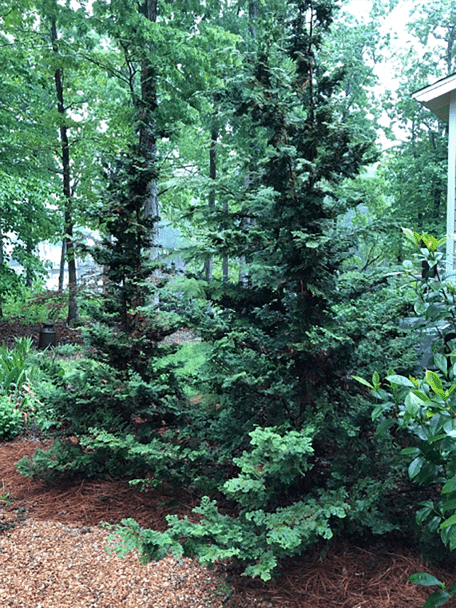
I love the sculpted textural appearance of this tree. Look for a cultivar such as Gracilis if you want it to stay tighter. It has a soft touch and is quite disease and pest free.
American Holly – Ilex opaca

While there are more readily available upright hollies out there, I’m still a fan of natives. American holly has bright red berries that the birds devour. If you want one that has been bred for some improved qualities, look for “Greenleaf” as a good cultivar.
Sweetbay magnolia – Magnolia virginica
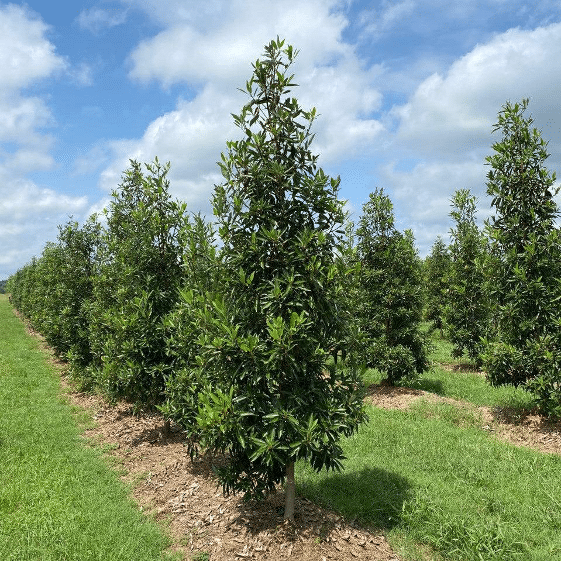
I put this under “Evergreen” but there are many that drop most of their leaves in the winter. Ask your nursery person about this. While the flowers of Sweetbay aren’t nearly as showy as Southern Magnolia, they are still there. This small tree has a light, airy quality and is most often purchased as a multi-stemmed plant.

Here is the cover of an Extension Publication I wrote hoping to convince developers that large trees were worth keeping. (Yep, that’s a picture of our house on the front 😉 )
So, there you are. A few fairly common but still very nice trees to consider if you’re looking to the great beyond.
Till next time,
HAPPY TREE SHOPPING!
Please share and subscribe! https://ahomeforyourgnome.com/

